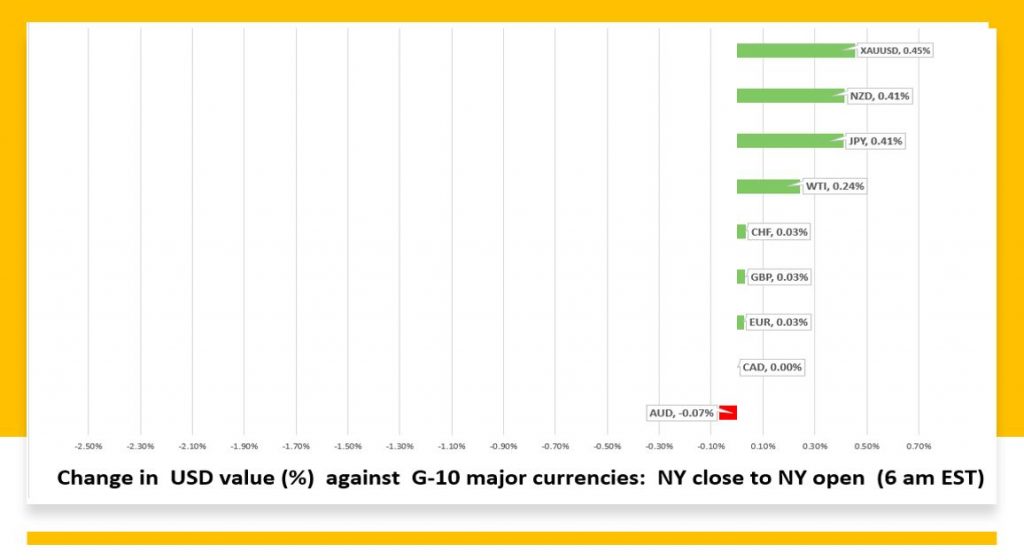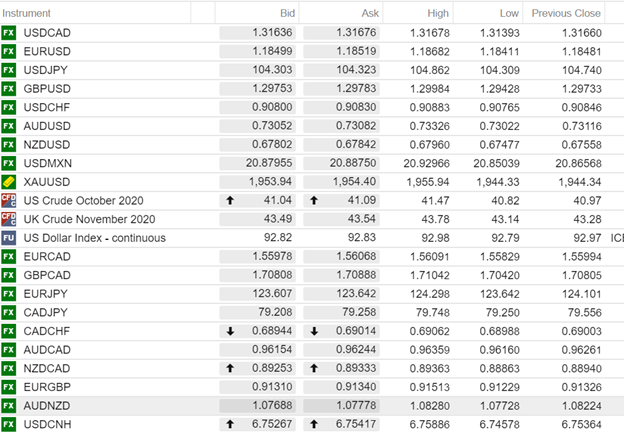
USDCAD open (6:00 am ET) 1.3164-68, Overnight Range 1.3139-1.3168
- Canada July Retail Sales rise 0.6%-forecast 1.0%
- GBPUSD firm as Brexit trade deal hopes offset negative rate fears
- Kiwi and JPY outperform overnight.
FX Ranges at a Glance

Source: IFXA Ltd/RP
FX Recap and Outlook: Canada Retail Sales did not live up to its advanced billing. Economists were expecting an upside surprise to their 1.0% m/m consensus forecast, because of pent-up demand as COVID-19 restrictions were eased. It didn’t happen. Retail Sales rose 0.6% m/m. The headline gains were driven by car sales and gasoline. Core Retails Sales dropped 0.4% m/m. The results were only a minor positive for USDCAD
US dollar bulls were in short supply overnight, but started coming out of the woodwork in NY. The post-FOMC greenback rally faded during yesterday’s NY session and continued in Asia and Europe, led by gains in the Japanese yen and New Zealand dollar.
Traders have concluded that the reaction to Wednesday’s FOMC meeting was misguided, as the Fed’s message didn’t change. They still do not have a clue why inflation is persistently low. Wall Street closed with losses, but they weren’t as bad as they were earlier in the session. China’s Shanghai Shenzhen CSI 300 index soared 2.25%, leading Asia equity markets higher. European equities are in the red, except the German DAX. Traders were spooked by jumps in coronavirus cases in some centers, particularly France. US equity futures are slightly negative.
GBPUSD rallied, sank, and rallied again in a somewhat choppy overnight session, only to open unchanged. UK Retail Sales rose 2.8% y/y in August but analysts warn the gains may not be sustained in the fall. GBPUSD is trading in NY near the top of its 1.2943-1.2998 range. Prices are supported by hopes of an EU/UK trade deal, while fears of negative rates act as a drag on gains.
EURUSD broke below key support in Asia yesterday, signalling steeper losses ahead. The signal was false. Prices bounced and continued to climb until peaking at 1.1868 in Europe today. They are consolidating in a 1.1840-60 range. EURUSD gains face headwinds from concerns about a second-wave COVID-19 outbreak. The World Health Organisation said COVID-19 cases are surging at an “alarming rate.”
USDJPY dropped on safe-haven, and Japanese half-year end JPY repatriation flows. In addition, USDJPY technicals turned bearish with the break below 105.05, looking for further losses to the 103.60 area.
NZDUSD outperformed its antipodean counterpart after Finance Minister Grant Robertson predicted a strong rebound in the economy for Q3. NZDUSD climbed to 0.6797 from 0.6748 but is giving back those gains in NY trading,
USDCAD dropped alongside broad US dollar weakness, as the currency pair continues to to-and-fro inside the well-travelled 1.3000-1.3260 range. USDCAD is tracking broad US dollar movements as evidenced by the chart below
Today’s Michigan Consumer Sentiment Index (forecast 75, vs previous 74.1) is only important to FX traders if Wall Street reacts aggressively to the results.
USDCAD Technicals: The intraday technicals are modestly bullish above 1.3140 looking for another test of resistance in the 1.3250-60 area. The following chart highlights the high correlation of USDCAD price movements to the US dollar index. For today, USDCAD support is at 1.3184 and 1.3110. Resistance is at 1.32305 and 1.3260. Today’s Range 1.3140-1.3210
Chart: USDCAD and USDX daily
Chart: USDCAD and USDX daily

Source: Saxo Bank
FX open (6:00 am EDT) High, Low, and previous close Source: Saxo Bank






